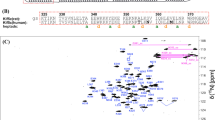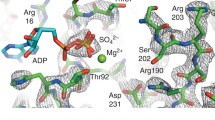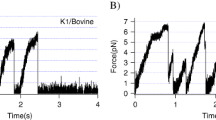Abstract
The 14- to 18-amino acid kinesin neck linker domain links the core motor to the coiled-coil dimerization domain. One puzzle is that the neck linker appears too short for the 4-nm distance each linker must stretch to enable an 8-nm step—when modeled as an entropic spring, high inter-head forces are predicted when both heads are bound to the microtubule. We addressed this by analyzing the length of the neck linker across different kinesin families and using molecular dynamics simulations to model the extensibility of Kinesin-1 and Kinesin-2 neck linkers. The force–extension profile from molecular dynamics agrees with the worm-like chain (WLC) model for Kinesin-1 and supports the puzzling prediction that extending the neck linker 4 nm requires forces multiple times the motor stall force. Despite being three amino acids longer, simulations suggest that extending the Kinesin-2 neck linker by 4 nm requires similarly high forces. A possible resolution to this dilemma is that helix α-6 may unwind to enable the two-head bound state. Finally, simulations suggest that cis/trans isomerization of a conserved proline residue in Kinesin-2 accounts for the differing predictions of molecular dynamics and the WLC model, and may contribute to motor regulation in vivo.






Similar content being viewed by others
References
Block, S. M., Kinesin motor mechanics: binding, stepping, tracking, gating, and limping. Biophys J 92:2986-2995, 2007.
Block, S. M., L. S. Goldstein, and B. J. Schnapp, Bead movement by single kinesin molecules studied with optical tweezers. Nature 348:348-352, 1990.
Bryson, K., L. J. McGuffin, R. L. Marsden, J. J. Ward, J. S. Sodhi, and D. T. Jones, Protein structure prediction servers at University College London. Nucleic Acids Res 33:W36-W38, 2005.
Case, R. B., S. Rice, C. L. Hart, B. Ly, and R. D. Vale, Role of the kinesin neck linker and catalytic core in microtubule-based motility. Curr Biol 10:157-160, 2000.
Cole, D. G., Kinesin-II, coming and going. J Cell Biol 147:463-466, 1999.
Delorenzi, M. and T. Speed, An HMM model for coiled-coil domains and a comparison with PSSM-based predictions. Bioinformatics 18:617-625, 2002.
Endow, S. A., Determinants of molecular motor directionality. Nat Cell Biol 1:E163-E167, 1999.
Fersht, A., Structure and Mechanism in Protein Science. 1998, New York: W.H. Freeman 631.
Gruber, M., J. Soding, and A. N. Lupas, Comparative analysis of coiled-coil prediction methods. J Struct Biol 155:140-145, 2006.
Guydosh, N. R. and S. M. Block, Backsteps induced by nucleotide analogs suggest the front head of kinesin is gated by strain. Proc Natl Acad Sci USA 103:8054-8059, 2006.
Hackney, D. D., M. F. Stock, J. Moore, and R. A. Patterson, Modulation of kinesin half-site ADP release and kinetic processivity by a spacer between the head groups. Biochemistry 42:12011-12018, 2003.
Hancock, W. O. and J. Howard, Processivity of the motor protein kinesin requires two heads. J Cell Biol 140:1395-1405, 1998.
Hancock, W. O. and J. Howard, Kinesin’s processivity results from mechanical and chemical coordination between the ATP hydrolysis cycles of the two motor domains. Proc Natl Acad Sci USA 96:13147-13152, 1999.
Hancock, W. O. and J. Howard, Kinesin: Processivity and chemomechanical coupling, in Molecular Motors, M. Schliwa, Editor. 2003, Wiley-VCH: Weinheim, Germany. p. 243-269.
Hirose, K., A. Lockhart, R. A. Cross, and L. A. Amos, Three-dimensional cryoelectron microscopy of dimeric kinesin and ncd motor domains on microtubules. Proc Natl Acad Sci U S A 93:9539-9544, 1996.
Hoeng, J. C., S. C. Dawson, S. A. House, M. S. Sagolla, J. K. Pham, J. J. Mancuso, J. Lowe, and W. Z. Cande. High resolution crystal structure and in vivo function of a Kinesin-2 homolog in Giardia intestinalis. Mol. Biol. Cell, 19:3124–3137, 2008.
Howard, J., Mechanics of Motor Proteins and the Cytoskeleton. 1st. ed. 2001, Sunderland, MA: Sinauer, 367.
Howard, J., A. J. Hudspeth, and R. D. Vale, Movement of microtubules by single kinesin molecules. Nature 342:154-158, 1989.
Hyeon, C. and J. N. Onuchic, Internal strain regulates the nucleotide binding site of the kinesin leading head. Proc Natl Acad Sci U S A 104:2175-2180, 2007.
Jones, D. T., GenTHREADER: an efficient and reliable protein fold recognition method for genomic sequences. J Mol Biol 287:797-815, 1999.
Jones, D. T., Improving the accuracy of transmembrane protein topology prediction using evolutionary information. Bioinformatics 23:538-544, 2007.
Jones, D. T., W. R. Taylor, and J. M. Thornton, A model recognition approach to the prediction of all-helical membrane protein structure and topology. Biochemistry 33:3038-3049, 1994.
Kashina, A. S., R. J. Baskin, D. G. Cole, K. P. Wedaman, W. M. Saxton, and J. M. Scholey, A bipolar kinesin. Nature 379:270-272, 1996.
Kellermayer, M. S., S. B. Smith, H. L. Granzier, and C. Bustamante, Folding-unfolding transitions in single titin molecules characterized with laser tweezers. Science 276:1112-1116, 1997.
Khalil, A. S., D. C. Appleyard, A. K. Labno, A. Georges, M. Karplus, A. M. Belcher, W. Hwang, and M. J. Lang, Kinesin’s cover-neck bundle folds forward to generate force. Proc Natl Acad Sci USA 105:19247-19252, 2008.
Kikkawa, M., E. P. Sablin, Y. Okada, H. Yajima, R. J. Fletterick, and N. Hirokawa, Switch-based mechanism of kinesin motors. Nature 411:439-445, 2001.
Kim, Y., J. E. Heuser, C. M. Waterman, and D. W. Cleveland, CENP-E combines a slow, processive motor and a flexible coiled coil to produce an essential motile kinetochore tether. J Cell Biol 181:411-419, 2008.
Kozielski, F., S. Sack, A. Marx, M. Thormahlen, E. Schonbrunn, V. Biou, A. Thompson, E. M. Mandelkow, and E. Mandelkow, The crystal structure of dimeric kinesin and implications for microtubule-dependent motility. Cell 91:985-994, 1997.
Kull, F. J., E. P. Sablin, R. Lau, R. J. Fletterick, and R. D. Vale, Crystal structure of the kinesin motor domain reveals a structural similarity to myosin. Nature 380:550-555, 1996.
Kwok, B. H., L. C. Kapitein, J. H. Kim, E. J. Peterman, C. F. Schmidt, and T. M. Kapoor, Allosteric inhibition of kinesin-5 modulates its processive directional motility. Nat Chem Biol 2:480-485, 2006.
Lawrence, C. J., R. K. Dawe, K. R. Christie, D. W. Cleveland, S. C. Dawson, S. A. Endow, L. S. Goldstein, H. V. Goodson, N. Hirokawa, J. Howard, R. L. Malmberg, J. R. McIntosh, H. Miki, T. J. Mitchison, Y. Okada, A. S. Reddy, W. M. Saxton, M. Schliwa, J. M. Scholey, R. D. Vale, C. E. Walczak, and L. Wordeman, A standardized kinesin nomenclature. J Cell Biol 167:19-22, 2004.
Lu, K. P., G. Finn, T. H. Lee, and L. K. Nicholson, Prolyl cis-trans isomerization as a molecular timer. Nat Chem Biol 3:619-629, 2007.
Lupas, A., Prediction and analysis of coiled-coil structures. Methods Enzymol 266:513-525, 1996.
Lupas, A., M. Van Dyke, and J. Stock, Predicting coiled coils from protein sequences. Science 252:1162-1164, 1991.
McDonnell, A. V., T. Jiang, A. E. Keating, and B. Berger, Paircoil2: improved prediction of coiled coils from sequence. Bioinformatics 22:356-358, 2006.
McGuffin, L. J. and D. T. Jones, Improvement of the GenTHREADER method for genomic fold recognition. Bioinformatics 19:874-881, 2003.
Miki, H., M. Setou, K. Kaneshiro, and N. Hirokawa, All kinesin superfamily protein, KIF, genes in mouse and human. Proc Natl Acad Sci USA 98:7004-7011, 2001.
Muthukrishnan, G., Y. Zhang, S. Shastry, and W. O. Hancock, The processivity of kinesin-2 motors suggests diminished front-head gating. Curr Biol 19:442-447, 2009.
Nagy, A., L. Grama, T. Huber, P. Bianco, K. Trombitas, H. L. Granzier, and M. S. Kellermayer, Hierarchical extensibility in the PEVK domain of skeletal-muscle titin. Biophys J 89:329-336, 2005.
Nogales, E., M. Whittaker, R. A. Milligan, and K. H. Downing, High-resolution model of the microtubule. Cell 96:79-88, 1999.
Oberhauser, A. F., P. K. Hansma, M. Carrion-Vazquez, and J. M. Fernandez, Stepwise unfolding of titin under force-clamp atomic force microscopy. Proc Natl Acad Sci U S A 98:468-472, 2001.
Okada, Y. and N. Hirokawa, A processive single-headed motor: kinesin superfamily protein KIF1A. Science 283:1152-1157, 1999.
Parry, D. A., Coiled-coils in alpha-helix-containing proteins: analysis of the residue types within the heptad repeat and the use of these data in the prediction of coiled-coils in other proteins. Biosci Rep 2:1017-1024, 1982.
Pauling, L., R. B. Corey, and H. R. Branson, The structure of proteins; two hydrogen-bonded helical configurations of the polypeptide chain. Proc Natl Acad Sci USA 37:205-211, 1951.
Rice, S., A. W. Lin, D. Safer, C. L. Hart, N. Naber, B. O. Carragher, S. M. Cain, E. Pechatnikova, E. M. Wilson-Kubalek, M. Whittaker, E. Pate, R. Cooke, E. W. Taylor, R. A. Milligan, and R. D. Vale, A structural change in the kinesin motor protein that drives motility. Nature 402:778-784, 1999.
Richardson, J. S. and D. C. Richardson, Amino acid preferences for specific locations at the ends of alpha helices. Science 240:1648-1652, 1988.
Rief, M., M. Gautel, F. Oesterhelt, J. M. Fernandez, and H. E. Gaub, Reversible unfolding of individual titin immunoglobulin domains by AFM. Science 276:1109-1112, 1997.
Romberg, L., D. W. Pierce, and R. D. Vale, Role of the kinesin neck region in processive microtubule-based motility. J Cell Biol 140:1407-1416, 1998.
Rosenfeld, S. S., P. M. Fordyce, G. M. Jefferson, P. H. King, and S. M. Block, Stepping and stretching. How kinesin uses internal strain to walk processively. J Biol Chem 278:18550-18556, 2003.
Rosenfeld, S. S., G. M. Jefferson, and P. H. King, ATP reorients the neck linker of kinesin in two sequential steps. J Biol Chem 276:40167-40174, 2001.
Sack, S., J. Muller, A. Marx, M. Thormahlen, E. M. Mandelkow, S. T. Brady, and E. Mandelkow, X-ray structure of motor and neck domains from rat brain kinesin. Biochemistry 36:16155-16165, 1997.
Sindelar, C. V. and K. H. Downing, The beginning of kinesin’s force-generating cycle visualized at 9-A resolution. J Cell Biol 177:377-385, 2007.
Song, Y. H., A. Marx, J. Muller, G. Woehlke, M. Schliwa, A. Krebs, A. Hoenger, and E. Mandelkow, Structure of a fast kinesin: implications for ATPase mechanism and interactions with microtubules. EMBO J 20:6213-6225, 2001.
Thorn, K. S., J. A. Ubersax, and R. D. Vale, Engineering the processive run length of the kinesin motor. J Cell Biol 151:1093-1100, 2000.
Tomishige, M., D. R. Klopfenstein, and R. D. Vale, Conversion of Unc104/KIF1A Kinesin into a Processive Motor After Dimerization. Science 297:2263-2267, 2002.
Tomishige, M. and R. D. Vale, Controlling kinesin by reversible disulfide cross-linking. Identifying the motility-producing conformational change. J Cell Biol 151:1081-1092, 2000.
Turner, J., R. Anderson, J. Guo, C. Beraud, R. Fletterick, and R. Sakowicz, Crystal structure of the mitotic spindle kinesin Eg5 reveals a novel conformation of the neck-linker. J Biol Chem 276:25496-25502, 2001.
Valentine, M. T., P. M. Fordyce, T. C. Krzysiak, S. P. Gilbert, and S. M. Block, Individual dimers of the mitotic kinesin motor Eg5 step processively and support substantial loads in vitro. Nat Cell Biol 8:470-476, 2006.
Valiaev, A., D. W. Lim, T. G. Oas, A. Chilkoti, and S. Zauscher, Force-induced prolyl cis-trans isomerization in elastin-like polypeptides. J Am Chem Soc 129:6491-6497, 2007.
Wolf, E., P. S. Kim, and B. Berger, MultiCoil: a program for predicting two- and three-stranded coiled coils. Protein Sci 6:1179-1189, 1997.
Yardimci, H., M. van Duffelen, Y. Mao, S. S. Rosenfeld, and P. R. Selvin, The mitotic kinesin CENP-E is a processive transport motor. Proc Natl Acad Sci USA 105:6016-6021, 2008.
Yildiz, A., M. Tomishige, A. Gennerich, and R. D. Vale, Intramolecular strain coordinates kinesin stepping behavior along microtubules. Cell 134:1030-1041, 2008.
Acknowledgments
The authors thank Matthew L. Kutys and John Fricks for helpful discussions. This work was supported by NIH Grant R01-GM076476 (to W.O.H.) and NSF DMS-0714939 (J. Fricks, PI).
Author information
Authors and Affiliations
Corresponding author
Rights and permissions
About this article
Cite this article
Hariharan, V., Hancock, W.O. Insights into the Mechanical Properties of the Kinesin Neck Linker Domain from Sequence Analysis and Molecular Dynamics Simulations. Cel. Mol. Bioeng. 2, 177–189 (2009). https://doi.org/10.1007/s12195-009-0059-5
Received:
Accepted:
Published:
Issue Date:
DOI: https://doi.org/10.1007/s12195-009-0059-5




